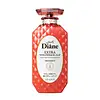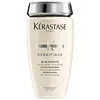What's inside
What's inside
 Key Ingredients
Key Ingredients

 Benefits
Benefits

 Concerns
Concerns

 Ingredients Side-by-side
Ingredients Side-by-side

Water
Skin ConditioningCetearyl Alcohol
EmollientEthylhexyl Palmitate
EmollientAsparagopsis Armata Extract
Skin ProtectingPropanediol
SolventGamma-Docosalactone
Skin ConditioningQuaternium-33
Glucose
HumectantButylene Glycol
HumectantGlucosyl Hesperidin
HumectantSorbitol
HumectantHydrolyzed Rice Protein
Skin ConditioningPrunus Domestica Seed Extract
EmollientGlycerylamidoethyl Methacrylate/Stearyl Methacrylate Copolymer
HumectantAscophyllum Nodosum Extract
Skin ConditioningSodium Hyaluronate
HumectantKeratin
Skin ConditioningPisum Sativum Sprout Extract
Skin ConditioningChamomilla Recutita Flower Extract
MaskingSpiraea Ulmaria Flower Extract
Skin ConditioningIsomalt
HumectantPolyquaternium-10
Polyquaternium-7
Hydrolyzed Collagen
EmollientHydrolyzed Silk
HumectantPCA Ethyl Cocoyl Arginate
MoisturisingAmodimethicone
Biotin
AntiseborrhoeicPouteria Sapota Seed Oil
EmollientSclerocarya Birrea Seed Oil
HumectantTheobroma Grandiflorum Seed Butter
Skin ConditioningMangifera Indica Seed Oil
EmollientPhytosteryl/Octyldodecyl Lauroyl Glutamate
Skin ConditioningUbiquinone
AntioxidantGlycine Soja Sterols
EmollientCeramide Ng
Skin ConditioningArgania Spinosa Kernel Oil
EmollientCeramide Ag
HumectantCeramide NP
Skin ConditioningCeramide AP
Skin ConditioningCeramide EOP
Skin ConditioningBis-Behenyl/Isostearyl/Phytosteryl Dimer Dilinoleyl Dimer Dilinoleate
EmollientChenopodium Quinoa Seed Oil
EmollientCarapa Guaianensis Seed Oil
Skin ConditioningAdansonia Digitata Seed Oil
EmollientDimethicone
EmollientSodium Lactate
Buffering1,2-Hexanediol
Skin ConditioningCholesterol
EmollientSalicylic Acid
MaskingO-Cymen-5-Ol
AntimicrobialGlyceryl Tri-Hydrogenated Rosinate
EmollientHydrogenated Lecithin
EmulsifyingPolyglyceryl-10 Laurate
Skin ConditioningSteartrimonium Chloride
PreservativeCetrimonium Chloride
AntimicrobialDicocodimonium Chloride
EmulsifyingQuaternium-18
Behentrimonium Chloride
PreservativeIsopropyl Alcohol
SolventGlycerin
HumectantPropylene Glycol
HumectantLactic Acid
BufferingTocopherol
AntioxidantDisodium EDTA
Phenoxyethanol
PreservativeParfum
MaskingCaramel
Cosmetic ColorantWater, Cetearyl Alcohol, Ethylhexyl Palmitate, Asparagopsis Armata Extract, Propanediol, Gamma-Docosalactone, Quaternium-33, Glucose, Butylene Glycol, Glucosyl Hesperidin, Sorbitol, Hydrolyzed Rice Protein, Prunus Domestica Seed Extract, Glycerylamidoethyl Methacrylate/Stearyl Methacrylate Copolymer, Ascophyllum Nodosum Extract, Sodium Hyaluronate, Keratin, Pisum Sativum Sprout Extract, Chamomilla Recutita Flower Extract, Spiraea Ulmaria Flower Extract, Isomalt, Polyquaternium-10, Polyquaternium-7, Hydrolyzed Collagen, Hydrolyzed Silk, PCA Ethyl Cocoyl Arginate, Amodimethicone, Biotin, Pouteria Sapota Seed Oil, Sclerocarya Birrea Seed Oil, Theobroma Grandiflorum Seed Butter, Mangifera Indica Seed Oil, Phytosteryl/Octyldodecyl Lauroyl Glutamate, Ubiquinone, Glycine Soja Sterols, Ceramide Ng, Argania Spinosa Kernel Oil, Ceramide Ag, Ceramide NP, Ceramide AP, Ceramide EOP, Bis-Behenyl/Isostearyl/Phytosteryl Dimer Dilinoleyl Dimer Dilinoleate, Chenopodium Quinoa Seed Oil, Carapa Guaianensis Seed Oil, Adansonia Digitata Seed Oil, Dimethicone, Sodium Lactate, 1,2-Hexanediol, Cholesterol, Salicylic Acid, O-Cymen-5-Ol, Glyceryl Tri-Hydrogenated Rosinate, Hydrogenated Lecithin, Polyglyceryl-10 Laurate, Steartrimonium Chloride, Cetrimonium Chloride, Dicocodimonium Chloride, Quaternium-18, Behentrimonium Chloride, Isopropyl Alcohol, Glycerin, Propylene Glycol, Lactic Acid, Tocopherol, Disodium EDTA, Phenoxyethanol, Parfum, Caramel
Water
Skin ConditioningSodium Laureth Sulfate
CleansingDisodium Cocoamphodiacetate
CleansingGlycol Distearate
EmollientHexylene Glycol
EmulsifyingSodium Lauryl Sulfate
CleansingSodium Chloride
MaskingParfum
MaskingSodium Benzoate
MaskingSodium Hydroxide
BufferingCitric Acid
BufferingCoco-Betaine
CleansingHydroxypropyl Guar Hydroxypropyltrimonium Chloride
Alcohol Denat.
AntimicrobialPolyquaternium-30
Salicylic Acid
MaskingCarbomer
Emulsion StabilisingHexyl Cinnamal
PerfumingArginine
MaskingGlutamic Acid
HumectantLinalool
PerfumingCitronellol
PerfumingSerine
MaskingAlpha-Isomethyl Ionone
PerfumingHydroxypropyltrimonium Hydrolyzed Wheat Protein
Skin ConditioningSodium Hyaluronate
Humectant2-Oleamido-1,3-Octadecanediol
Skin ConditioningSafflower Glucoside
Geraniol
PerfumingPhenoxyethanol
PreservativeTocopherol
AntioxidantSodium Citrate
BufferingWater, Sodium Laureth Sulfate, Disodium Cocoamphodiacetate, Glycol Distearate, Hexylene Glycol, Sodium Lauryl Sulfate, Sodium Chloride, Parfum, Sodium Benzoate, Sodium Hydroxide, Citric Acid, Coco-Betaine, Hydroxypropyl Guar Hydroxypropyltrimonium Chloride, Alcohol Denat., Polyquaternium-30, Salicylic Acid, Carbomer, Hexyl Cinnamal, Arginine, Glutamic Acid, Linalool, Citronellol, Serine, Alpha-Isomethyl Ionone, Hydroxypropyltrimonium Hydrolyzed Wheat Protein, Sodium Hyaluronate, 2-Oleamido-1,3-Octadecanediol, Safflower Glucoside, Geraniol, Phenoxyethanol, Tocopherol, Sodium Citrate
Alternatives
Ingredients Explained
These ingredients are found in both products.
Ingredients higher up in an ingredient list are typically present in a larger amount.
Parfum is a catch-all term for an ingredient or more that is used to give a scent to products.
Also called "fragrance", this ingredient can be a blend of hundreds of chemicals or plant oils. This means every product with "fragrance" or "parfum" in the ingredients list is a different mixture.
For instance, Habanolide is a proprietary trade name for a specific aroma chemical. When used as a fragrance ingredient in cosmetics, most aroma chemicals fall under the broad labeling category of “FRAGRANCE” or “PARFUM” according to EU and US regulations.
The term 'parfum' or 'fragrance' is not regulated in many countries. In many cases, it is up to the brand to define this term.
For instance, many brands choose to label themselves as "fragrance-free" because they are not using synthetic fragrances. However, their products may still contain ingredients such as essential oils that are considered a fragrance by INCI standards.
One example is Calendula flower extract. Calendula is an essential oil that still imparts a scent or 'fragrance'.
Depending on the blend, the ingredients in the mixture can cause allergies and sensitivities on the skin. Some ingredients that are known EU allergens include linalool and citronellol.
Parfum can also be used to mask or cover an unpleasant scent.
The bottom line is: not all fragrances/parfum/ingredients are created equally. If you are worried about fragrances, we recommend taking a closer look at an ingredient. And of course, we always recommend speaking with a professional.
Learn more about ParfumPhenoxyethanol is a preservative that has germicide, antimicrobial, and aromatic properties. Studies show that phenoxyethanol can prevent microbial growth. By itself, it has a scent that is similar to that of a rose.
It's often used in formulations along with Caprylyl Glycol to preserve the shelf life of products.
Salicylic Acid (also known as beta hydroxy acid or BHA) is a well-known ingredient for treating skin that struggles with acne and clogged pores. It exfoliates both the skin's surface and deep within the pores to help clear out buildup, control oil, and reduce inflammation.
Unlike AHAs (alpha hydroxy acids), salicylic acid is oil-soluble. This allows it to penetrate into pores which makes it especially effective for treating blackheads and preventing future breakouts.
Salicylic acid is also known for its soothing properties. It has a similar structure to aspirin and can calm inflamed or irritated skin, making it a good option for acne-prone skin that is also sensitive.
Concentrations of 0.5-2% are recognized by the U.S. FDA as an over-the-counter topical acne product.
It can cause irritation and/or dryness if one's skin already has a compromised moisture barrier, so it's best to focus on repairing that before introducing this ingredient into your routine.
While salicylic acid does not increase sun sensitivity, it’s still important to wear sunscreen daily to protect your skin.
If you are looking for the ingredient called BHA or Butylated Hydroxyanisole, click here.
Learn more about Salicylic AcidSodium Hyaluronate is hyaluronic acid's salt form. It is commonly derived from the sodium salt of hyaluronic acid.
Like hyaluronic acid, it is great at holding water and acts as a humectant. This makes it a great skin hydrating ingredient.
Sodium Hyaluronate is naturally occurring in our bodies and is mostly found in eye fluid and joints.
These are some other common types of Hyaluronic Acid:
Learn more about Sodium HyaluronateTocopherol (also known as Vitamin E) is a common antioxidant used to help protect the skin from free-radicals and strengthen the skin barrier. It's also fat soluble - this means our skin is great at absorbing it.
Vitamin E also helps keep your natural skin lipids healthy. Your lipid skin barrier naturally consists of lipids, ceramides, and fatty acids. Vitamin E offers extra protection for your skin’s lipid barrier, keeping your skin healthy and nourished.
Another benefit is a bit of UV protection. Vitamin E helps reduce the damage caused by UVB rays. (It should not replace your sunscreen). Combining it with Vitamin C can decrease sunburned cells and hyperpigmentation after UV exposure.
You might have noticed Vitamin E + C often paired together. This is because it is great at stabilizing Vitamin C. Using the two together helps increase the effectiveness of both ingredients.
There are often claims that Vitamin E can reduce/prevent scarring, but these claims haven't been confirmed by scientific research.
Learn more about TocopherolWater. It's the most common cosmetic ingredient of all. You'll usually see it at the top of ingredient lists, meaning that it makes up the largest part of the product.
So why is it so popular? Water most often acts as a solvent - this means that it helps dissolve other ingredients into the formulation.
You'll also recognize water as that liquid we all need to stay alive. If you see this, drink a glass of water. Stay hydrated!
Learn more about Water